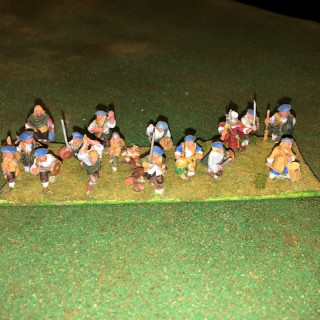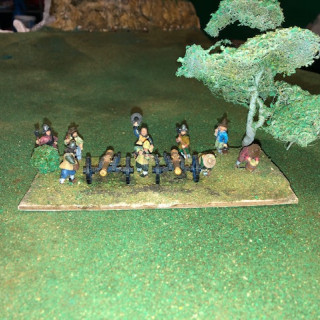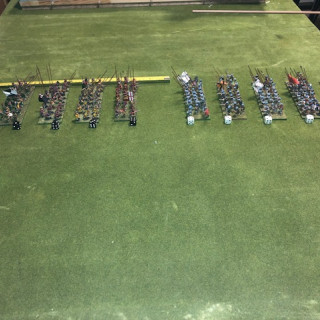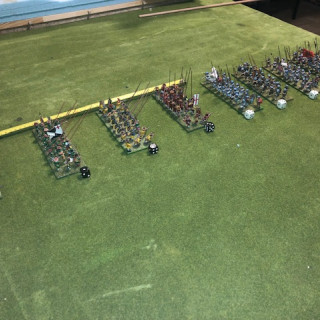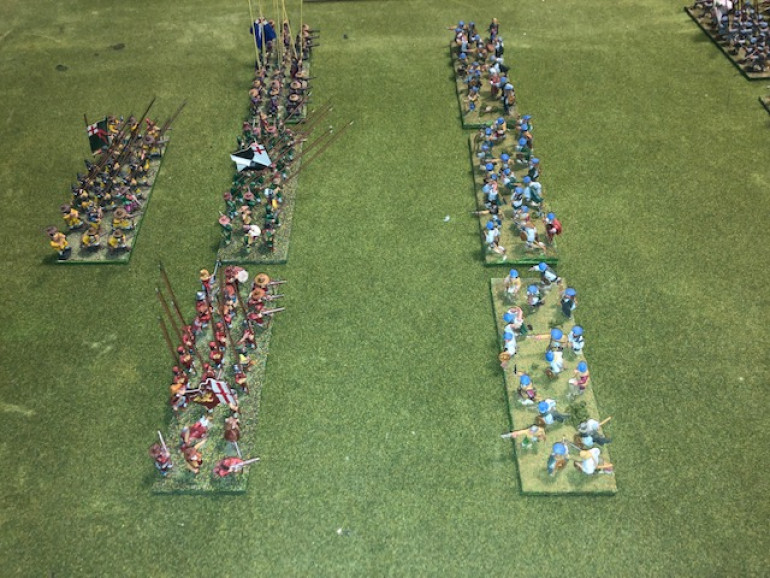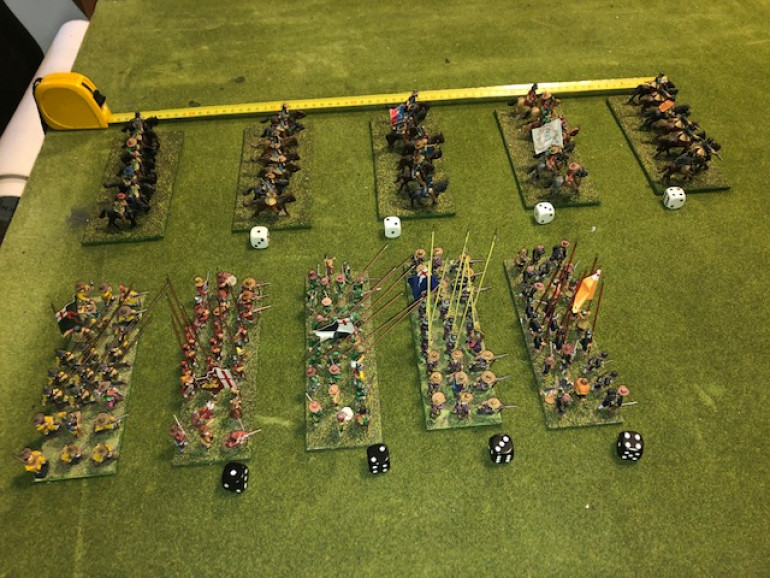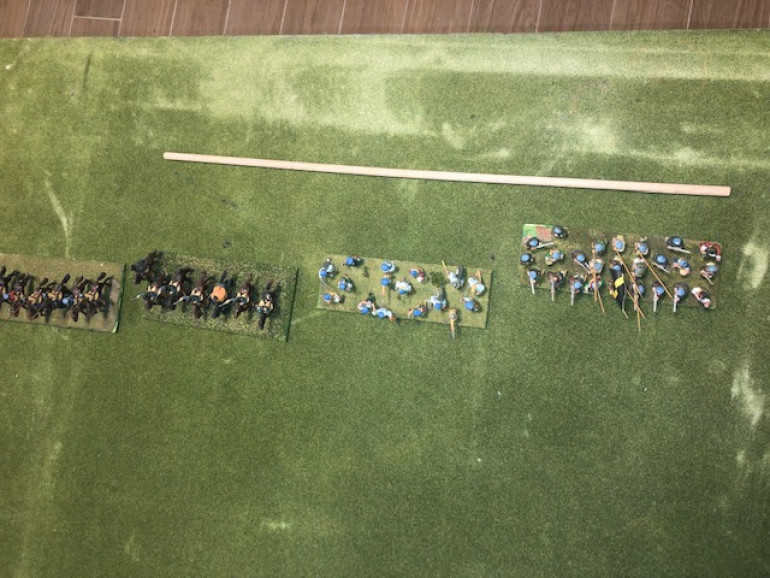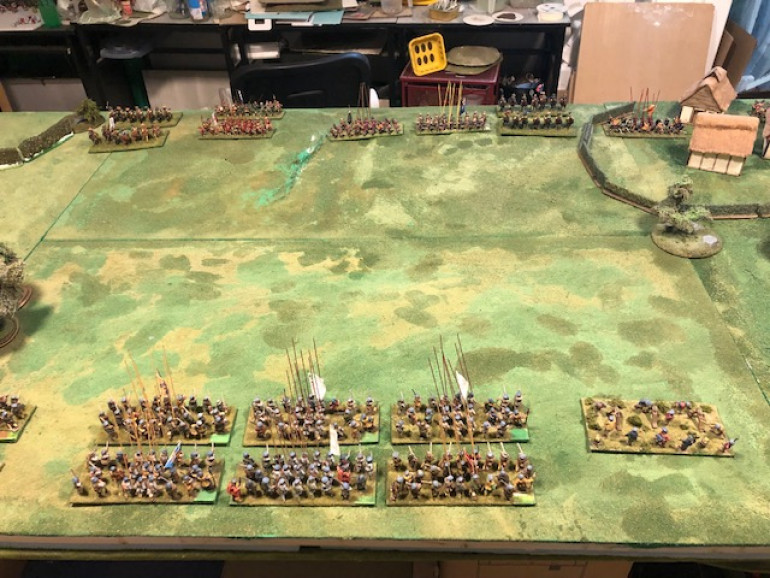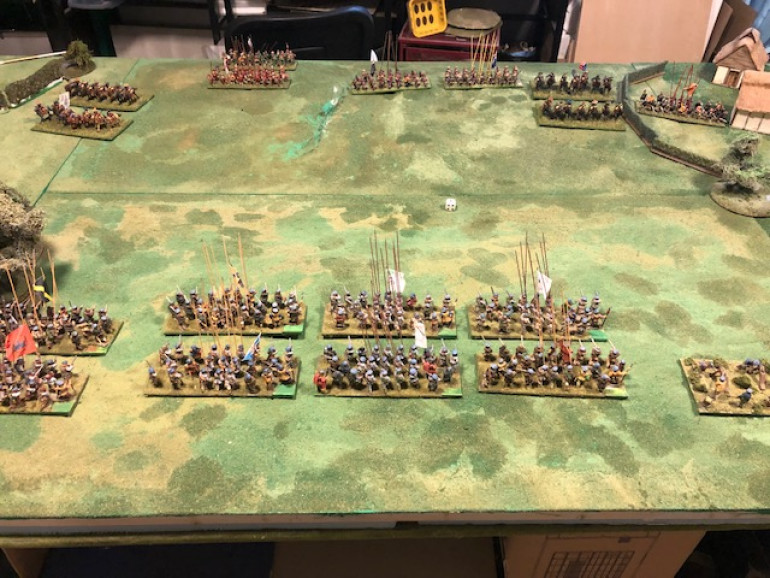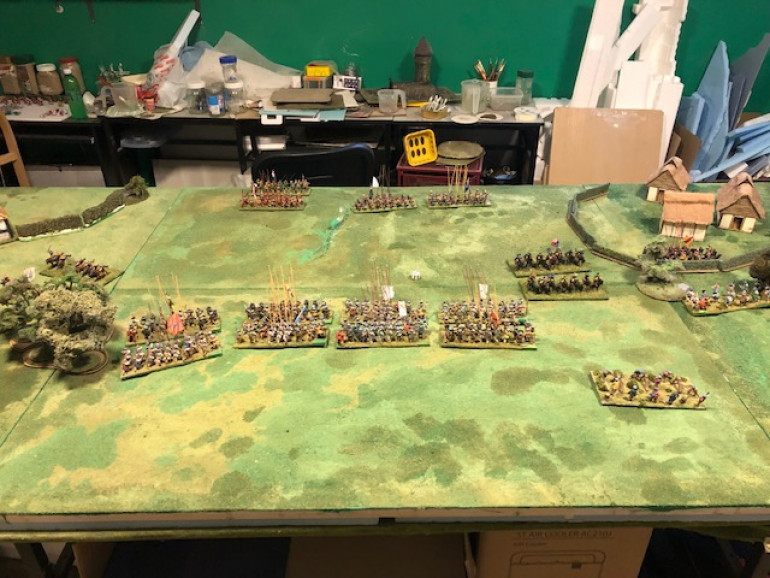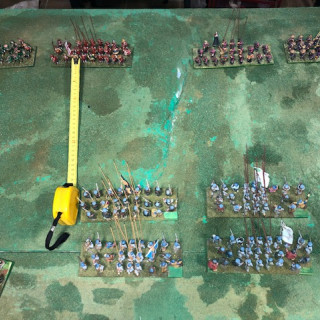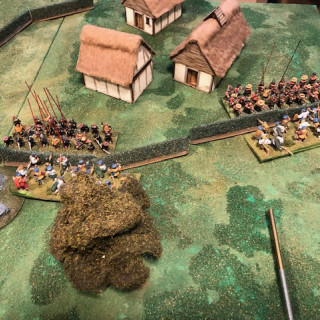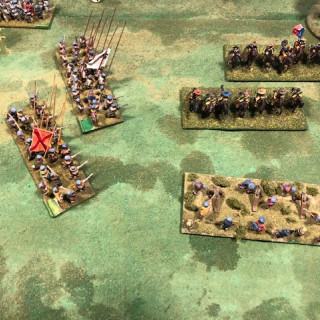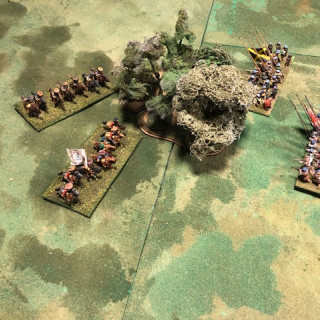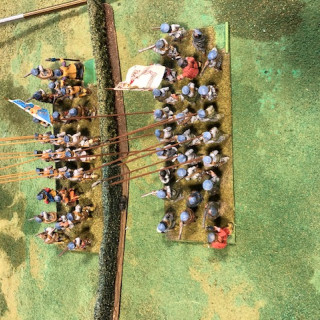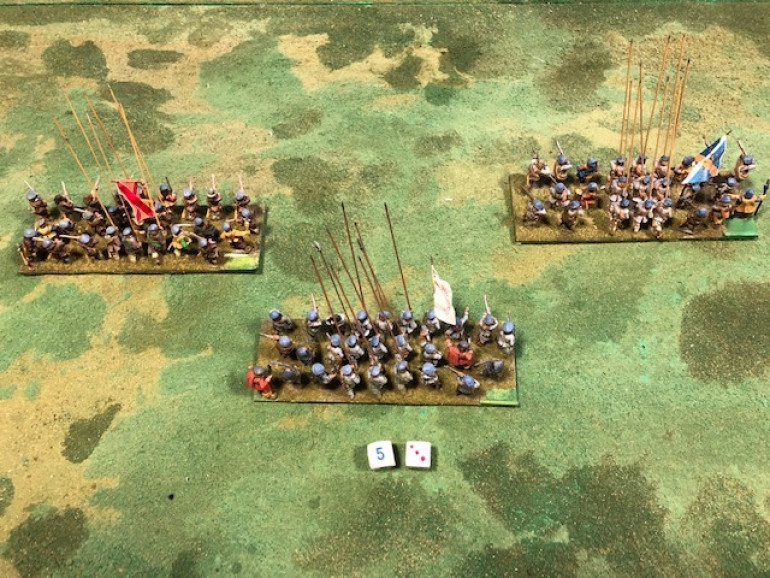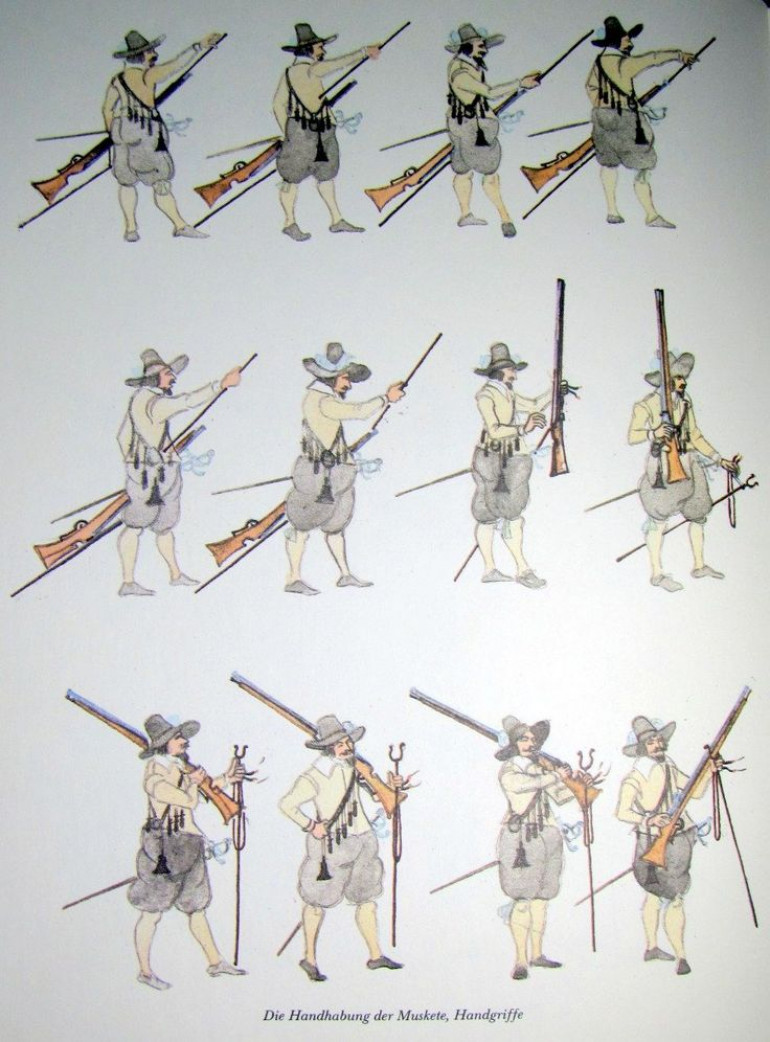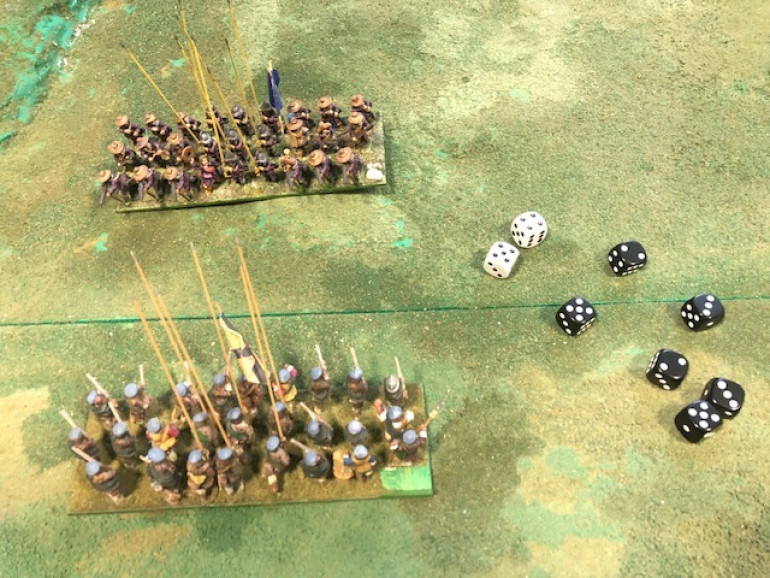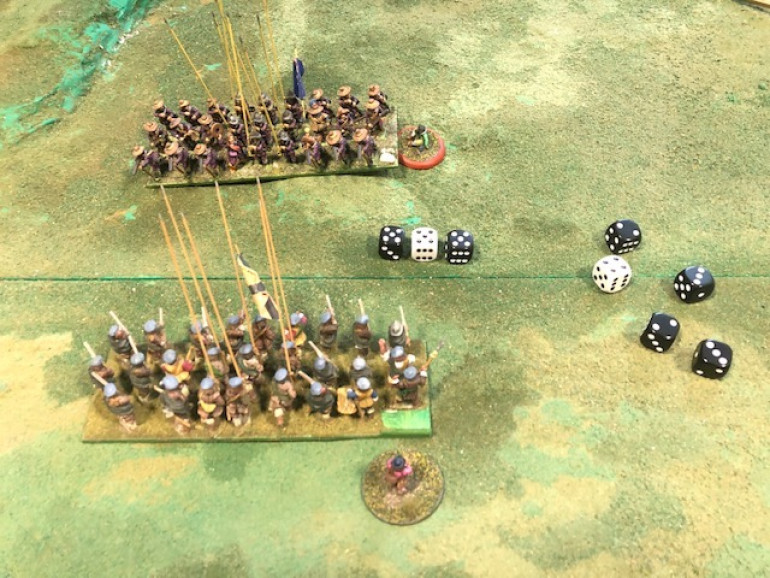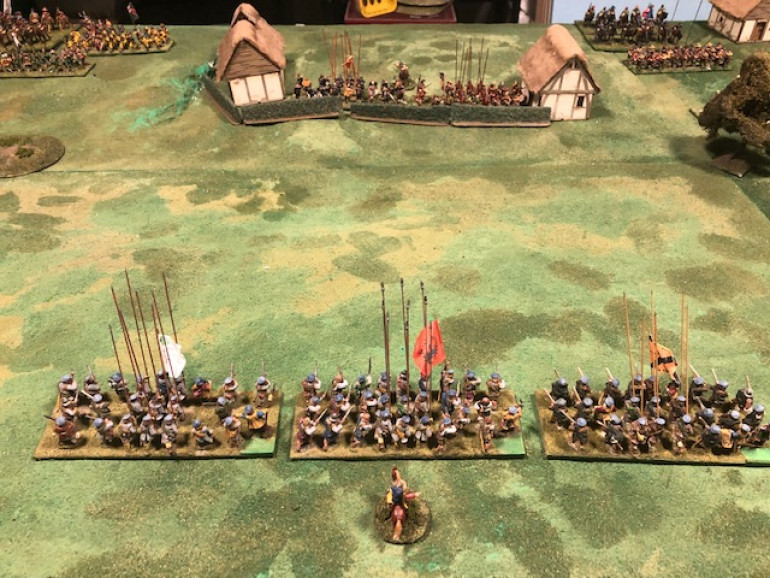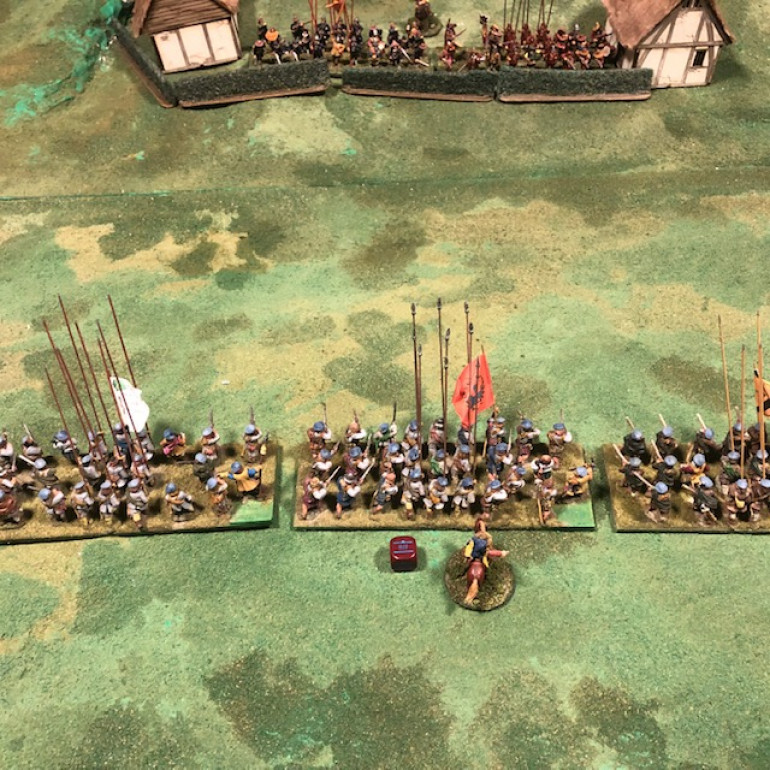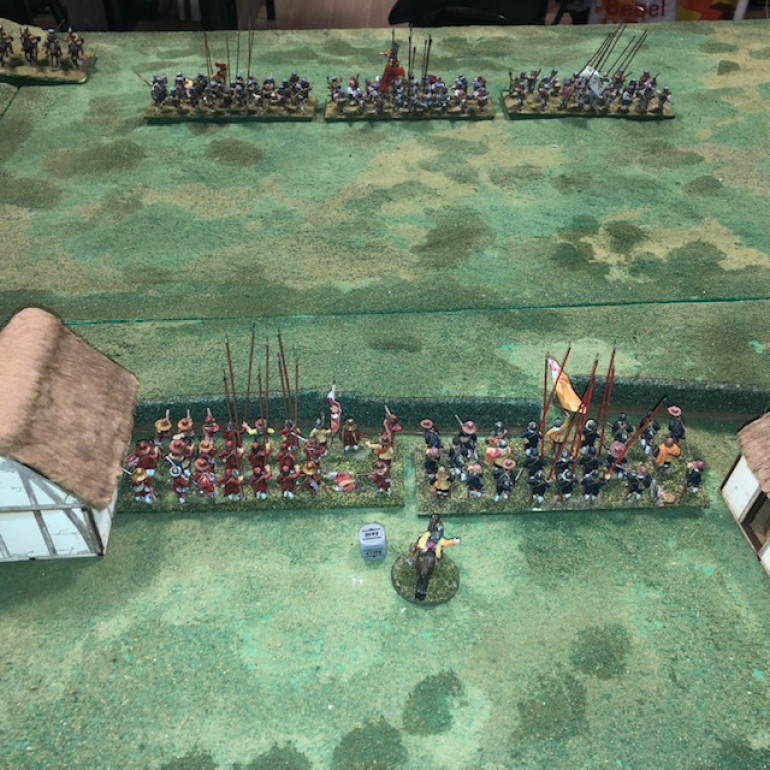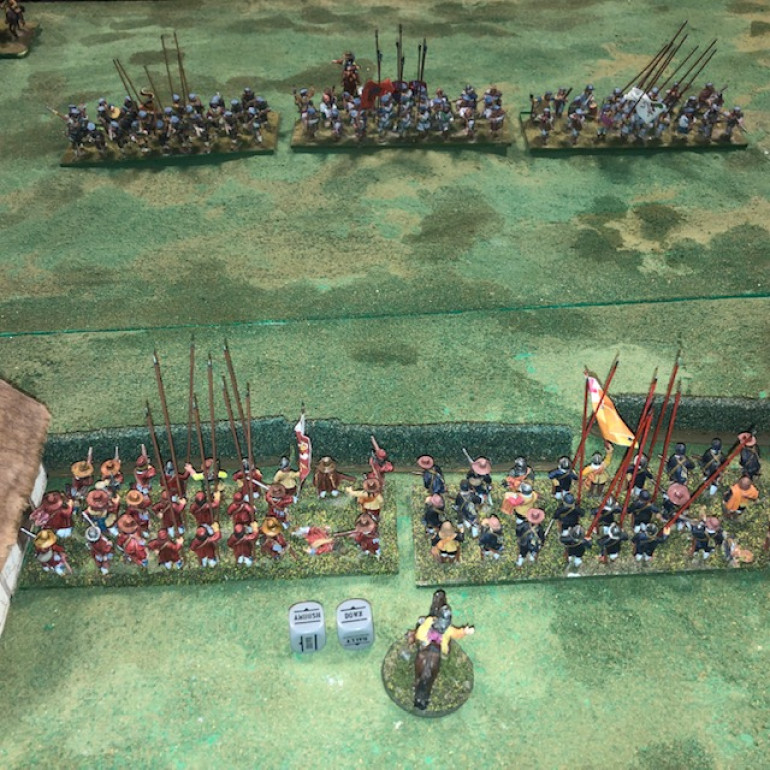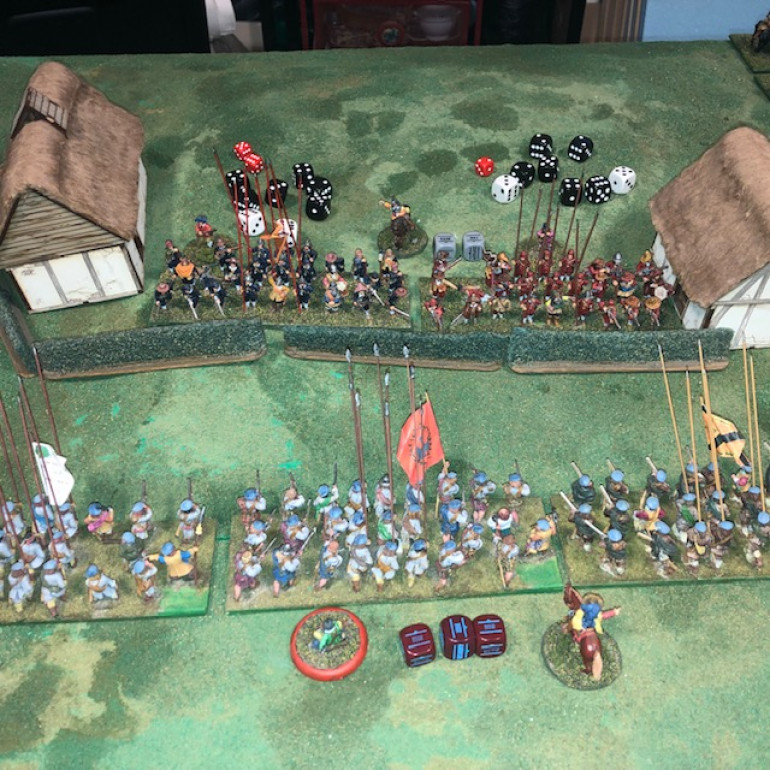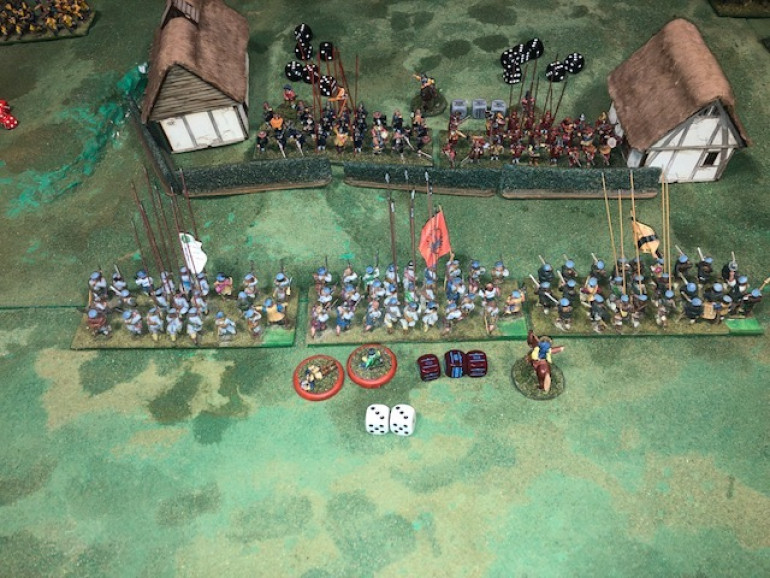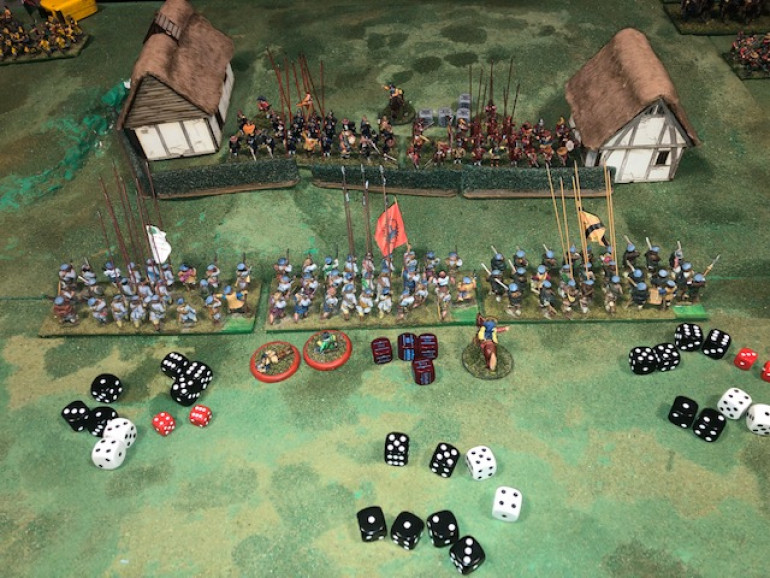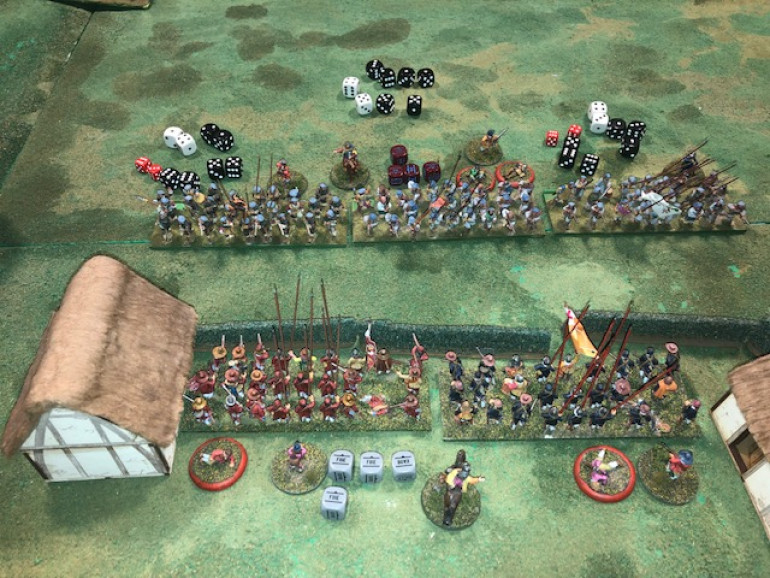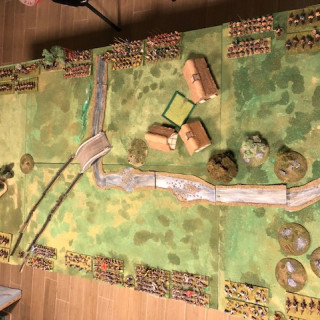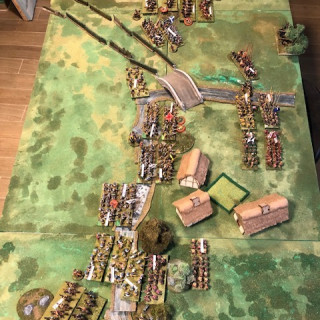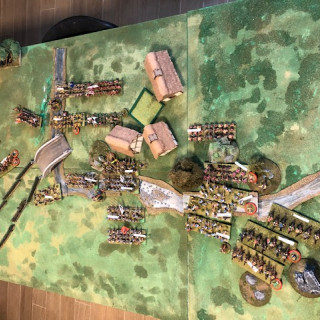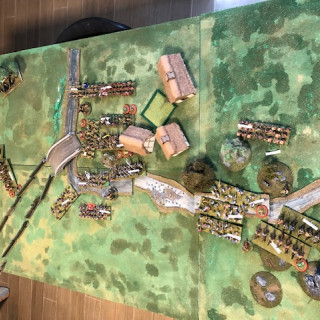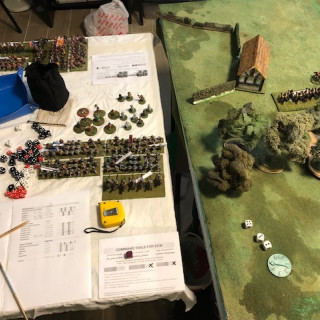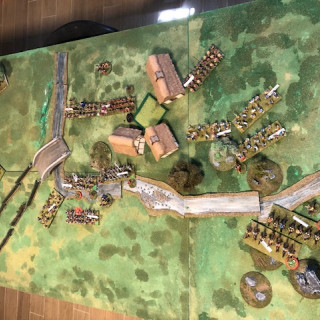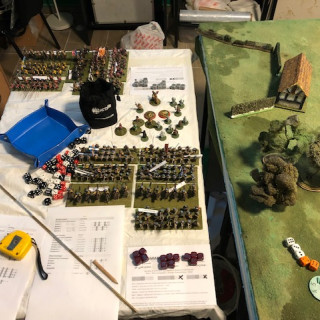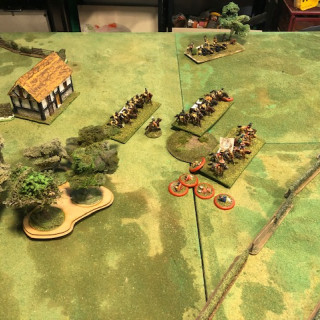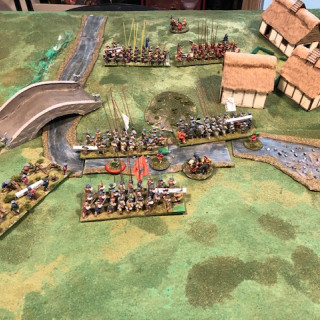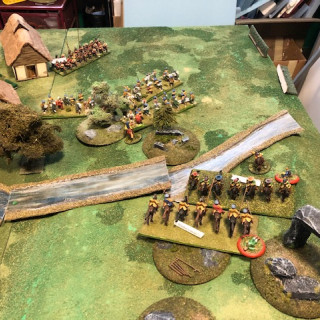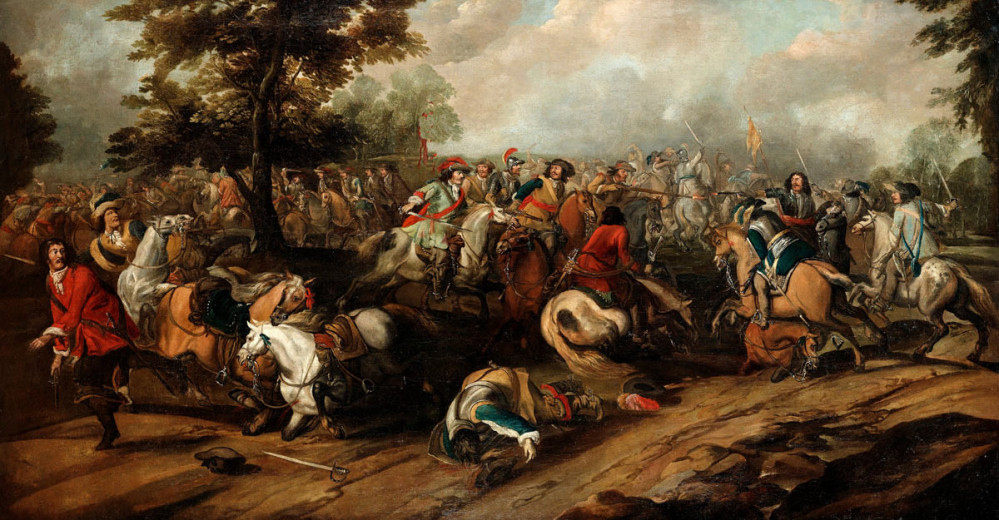
ECW: Time to make war
Recommendations: 205
About the Project
Last year I painted some of the ECW figures I have had for decades and now it’s time to finalise the rules I want to use them with. This project will track my thoughts and approach to the task of creating a set of rules for both simplistic play with my 11 year old, and a more complex “advanced” rules for my own solo campaigns.
Related Genre: Historical
This Project is Completed
Introduction
Firstly I want to set some basic criteria for the rules I want to use. As I prefer unit “bases” rather than individual figures I picked up a copy of Principles of War: Renaissance many years ago which use this concept. This basing approach is common to other rule sets, such as Impetus or Kings of War and appeals to me.
So the standard base is 18cm wide for all arms. This also allows for a “diorama” base rather than just several rows of figures in rank & file formation. That said in the ECW most Pike & Shot units would be in this more rigid format, but irregular troops and artillery lend themselves to some artistic discretion (see pictures).
There will be no fixed number of turns, unlike some games (e.g. Bolt Action 6 +1 turns, or KoW etc.) unless the scenario dictates this, so there does not need to be any restriction here.
It’s a “game” not a simulation, so I am not too concerned about ground scale, although the base frontage could be used for standard movement, something common in other rules, such as LaSalle or Impetus. I am not yet fixed on this at the moment.
There will not be a wide range of weapon options. At this time musketry was still developing and all troops were similarly equipped. So, essentially muskets will fire at “such and such” a distance, pistols similar, cannon split into 2/3 types, but that’s about it. “Effective” ranges and long range should be considered as an additional factor as they are in most rule sets, but that’s as far as I want that consideration to go. No multiple range options.
The biggest challenge for me is the command and control issue. There were some outstanding commanders in this period, but also some absolute duffers, add in frequent political and religious interference in army command and the variety of command levels increased. How to factor these in is something to think over.
Two final considerations; unit “morale” and unit “quality”. Again the aim is to make this as straightforward as possible without oversimplification. At the moment to take the latter, I envisage three troop qualities: Raw, Trained, Experienced (I guess an Elite class is also possible, but very few units would be considered this good, so I’m not sure it’s worth doing, but I’ll see).
For morale I am thinking instead of what I refer to as “Cohesion” rather than morale alone. This would also include their on-going ability to fight well, rather than simply their desire to remain on the battlefield. As the cohesion reduces, the unit becomes less effective in combat, so needs to be reflected in the rules somehow. At a certain point when cohesion drops to a critical level, the unit simply routes. This would be similar to the KoW approach with ‘wavering’ and ‘routing’ levels. Although exactly how that would be in practice, I’ll have to think through.
So, the plan is to take the rule concepts piece by piece and publish my thoughts as I go, concluding with sharing a final rule set once it’s done. I will “borrow” ideas from many other rules sets, so I doubt any of the ideas will be truly unique, but you never know.
Comments and thoughts are of course welcome. Wish me luck.
Movement
On the face of it, move rates would seem to be the simplest of criteria for a game where both sides (or all sides!) were virtually identical and there were no significant differences between troop qualities. The issue therefore becomes one of manoeuvre and the speed at which forces would come into contact.
In the ECW infantry units had to move as “fast” as the slowest element. The Pikemen had to keep to a solid formation as far as possible so as to ensure maximum protection in the event of cavalry interference. What this meant in practice was that movement was relatively slow, particularly compared to modern drilled troops. Of course, ECW battalions weredrilled, but the complexity of the moves meant they were slow and steady.
What does this mean for infantry move rates on the table top? Most games of the period suggest rates that might be considered extremely slow. 6” (15 cm) is common, and PoW actually suggests 4” (10 cm) for formed up units.
On a standard 6×4 table, assuming armies fight from the long sides and based on 15 cm movement (i.e. 6”), it would take 2 full turns each side for two infantry units to come to long range musket fire (at the moment I am thinking long range at 30 cm rather than anything shorter), or a further turn each to get into melee combat.
At the shorter move rate of 10 cm, this turn requirement increases to 4 turns for fire or 5 for melee. An additional factor to consider is the charge move. But in practical terms due to the use of the pike, any P&S unit could not practically “charge” the enemy. A slow advance ending with the “push of pikes”, a glorified scrum, was the usual practice – if it comes to that point at all.
The above pictures show the different movement rates in “action”. The 15 cm rate significantly reduces the time to reach combat, but I’m not convinced that this reflects the actual battle dynamics of the period. The shorter move ‘feels’ right.
What of irregular infantry, e.g. Scottish Highlanders who did not form up in pike & shot units? As they do not have to maintain a fixed formation, they would be freer to move, so a basic movement should be faster than the P&S blocks. However this should not be too exaggerated, and for the purpose of the game an extra 2-3 cm for a basic move should reflect their different character without giving them an excessive advantage.
Irregular infantry CAN charge, as they do not have to maintain a carefully formed line, so the final charge is 1.5 times the standard move.
Cavalry have a broadly similar set of criteria. When in battle, cavalry did not charge hell for leather as we see in the movies, but rather trotted or cantered to within charge range and saved to horses for the final rush in. For movement, therefore, I think it reasonable to reduce cavalry move rates until they enter a charge range. So a basic move relative to infantry of 1:1.5 i.e. if 10 cm is the base infantry move, cavalry would have a 15 cm allowance for a standard move.
The image below shows the relative distances for infantry and cavalry over a 4 move sequence. The extra range of cavalry might appear to make them a major asset in an ECW battle, but in reality the pikes kept the horses at bay, and most cavalry engagements were between two opposing cavalry forces. When attacking infantry it was common for cavalry to adopt the caracole practice of riding within pistol range, firing into the massed ranks of infantry and retiring to reload while the second (and/or third) wave followed up. Of course some heavier cavalry did engage directly with infantry, but this is for another rule section.
Artillery would rarely move, and if it did it would take a long time and require many men and horses. So for the purpose of these rules, I envisage artillery being placed during set up and immovable thereafter.
Officers and aide-de-camp can move at a fast rate as in practice these would be individuals generally moving as fast as possible with no formation issues to maintain. In the simple game rules I do not envisage anything obstructing these figures, but perhaps some complications can be introduced later.
On balance I am leaning towards the shorter movement rates for infantry, which then impacts on the other rates, as this was NOT generally a period of fast manoeuvre.
So to summarise movement:
Formed Infantry standard move = 10 cm
Formed Infantry no charge move standard move into melee
Irregular Infantry standard move = 12 cm
Irregular Infantry charge move = 18 cm
Cavalry (all types) standard move = 15 cm
Trotters (i.e. caracole units) no charge/engage at pistol range
Gallopers (i.e. engage with sword) = 18 cm
Light horse/lancers standard move = 15 cm
Light horse/lancers charge move = 20 cm
Officers / aide-de-camp move = 25 cm
The picture shows the relative movement for the different troop types.
Of course additional complications can be introduced, and probably will be for terrain effects, command decisions, unknown complications etc. all of which can impact on actual movements. But these I will consider for any “Advanced” rule amendments for later.
Now time to play test some of these movement rates to see if it “feels” right.
Movement in practice
My main “concern” with the movement rates I am considering is whether these relatively slow rates would impact on game play to such an extent that things become protracted. As a Solo player, this is less of an issue, but when playing with my son, I don’t want him to become bored. So for the “young man’s” game, I may increase these slightly. We’ll see
I set up a simple arrangement on my 4’ x 8’ table with minimal terrain features. The scenario is a Scottish covenanter army approaching a village guarded by a small number of P&S and Cavalry. The “defenders” have no artillery, but the Scots no cavalry. The forces are unbalanced by design.
Initial dispositions.
The first move brought the Scots forward across the line. English army centre did not move nut both cavalry wings advanced. The two battalions on the English left moved to take position behind the hedges in the village.
As can be seen, the movement allowance shows the slow advance of most P&S units of the time. Keeping in formation, particularly while carrying an 18’ pole, is relatively easy so long as you are not moving too fast.
By move 3 the Scottish centre line had advanced to almost the middle of the board, and had the English also moved they would be within musket range. On the wings, the cavalry are in charge range, should they wish to do so.
The Scottish highlanders on the Scottish Right wing are within charge range of the two battalions defending the village. These forces are behind high hedges, so a charge may not be the best course of action – but given these are Highlanders, I’m sure they will go in!
On the Scottish left, the two left-most battalions have to bring themselves around to face off a possible charge by the English coming around the small copse.
Finally, the “leather” guns will have time to discharge a volley into the oncoming English Cavalry before running for cover somewhere.
So, by move three some degree of aggressive action is possible across the entire frontage of the battle lines.
The following two moves enabled the forces to really engage in combat and battle was commenced on the wings. In the centre both armies are within musket range and a fire fight is about to begin.
Any increase in movement rates would bring the forces together faster, but perhaps at the expense of more subtlety in decision-making. So, for now at least, I will keep the movement rates as is. However, as these will have a knock on effect on musket ranges, some change may still occur.
Movement – Complications
In previous posts I presented the basic movement rates for the (relatively) small number of troop types. Essentially this reflects reality as well as making the rules simple. But I did not yet consider possible variations and treatment of obstacles. So here are a few more thoughts.
Obstacles are usually represented in rules as a reduction in the overall movement allowance. This makes sense as the turns are generally based on a time period, be it minutes or whatever. This makes the rules easy to understand and to play. Although I have seen some rules that have variable time rates, I’ll stick with the usual for now.
So, what are we talking about when it comes to obstacles for troop movement? Bearing in mind the troop types prevalent in the period, their equipment, drill manoeuvres etc.?
I think there are essentially three types of obstacle encountered on the wargame table: Linear terrain (i.e. walls, hedges, rivers); Area terrain (e.g. muddy ground, uneven ground, low hills); and Blocking terrain such as high hills, buildings etc.
The latter is simple. Anything designated as blocking terrain can not be traversed and must be circumnavigated. Usually a wargame table would not have too much of this, and not in critical positions (exceptions are skirmish 1:1 games like Bolt Action or Infinity where LoS blocking is not only desirable but a game requirement). So all that’s required is to clarify any terrain were there is some doubt.
Area effect terrain is also fairly straightforward, I think. A marsh is a marsh and will slow down movement, a steep hill also (both up and down), rough terrain i.e. rocky etc. also. What matters in the period to it maintain a unit’s coherence (particularly infantry) and that means taking more time to maintain it over bad terrain. So, what should be the penalty?
Many rules adopt a %age approach, i.e. reduce movement by 50% and I think that’s also a reasonable option. So for area effect terrain, movement is reduced by a half. If a unit cannot traverse the terrain in one move, they will also suffer the penalty on their next turn.
Crossing a river might take longer and the unit remains in the terrain feature until the next turn.
Linier terrain I will treat slightly differently. I think cavalry would simply jump over a hedge or wall and an inclined NOT to make any reduction at all for them. Infantry, especially Pikemen would take a lot longer to climb a wall/hedge and then need to form up again afterwards.
My inclination is to make a move reduction in cms, rather than a percentage. So for example a standard P&S unit would lose 4cm of it’s movement allowance to traverse a linier obstacle. However, an irregular unit that doesn’t carry 18’ pikes would not be so inconvenienced, and therefore only reduce their move by 2cm.
Not sure the impact in practice, so will test these out.
There is another aspect of movement which is not used in many rule sets, and that is variable movement. A typical battle field is not the pristine, flat billiard table that we have, but despite “looking” nice and uniform, actually comprises small peaks and troughs, hidden holes, irregular ground, minor wet patches etc. I wonder if we should think about this in our games? While I doubt I’ll use this when playing with my son, I am intrigued to test this out by myself.
Such an approach would introduce an element of uncertainty in movement (as I think is reflected in real history) and could be adopted with a minimum of additional dice throws. My initial thought is to use two average dice (numbered 2, 3, 3, 4, 4, 5) in Red and Green. For each movement command the dice are thrown and the difference (if any) is reflected in an addition or reduction in movement. i.e. a Red 5 and Green 3 would be a -2 movement; whereas a Green 4 and Red 2 would be a +2 movement.
Is this too much complexity? Perhaps, but in a solo campaign when time (and complication) is not really an issue, it might introduce a further “fog of war” to the game.
So in summary, movement allowances will be impacted by terrain features:
Linier terrain reduces infantry rates by 2 – 4 cm depending on unit type
Area terrain reduces all units by 50%
IT's time to unleash fire power!
A key aspect of any wargame rules are of course how to inflict pain on your enemy! And ECW is no different. My thinking here is to try to ensure that firepower doesn’t dominate the table and that movement is possible without totally risking a wipe-out. So the key, I think, is how you link movement to firepower.
Basically I’ll have three types of firing. Pistols (essentially used by “Trotter” cavalry at relatively short range), Musket fire from either a standard Pike & Shot unit or a “Commanded shot” unit (i.e. one that only comprises musket men”, and artillery.
I have established basic movement rates, particularly for formed up infantry, at 10cm. With that basis set, maximum musket range should fit into this criteria in a way that doesn’t overpower a P:S unit moving into either its own musket range, or on to the push of pikes.
My objective is to try to have a situation where an advancing unit should only suffer one ranged attack at “effective” range during an advance (assuming their commander isn’t an idiot) before either engaging in a fire-fight, or moving closer into melee combat.
So for Muskets the drill was complex, which will be reflected in how many dice are used depending on when the volley is charged. A unit of P:S can make a volley attempt at any time, but if it’s a first volley, or they have spent one turn “reloading” they will get extra dice. (as a gaming mechanism, I will use “reload” models to indicate if a unit is properly set for the volley or not).
I envisage a range set at maximum 30cm, but effective at 15cm. The difference will be the potential severity of the musket volley. Pistols will only have a short range option of 5cms. Artillery is more complex. Although cannon were not particularly effective (at least according to battle reports I’ve read), they can reach the length of a war game table, even if at these maximum ranges their effect would be modest, to say the least. So I’ll probably look at short, medium and long range for artillery.
So, as it stands the fire power of these three types of arm will be:
Pistol: Range 5cm
Musket: Close range up to 15 cm; Long range up to 30cm
Artillery: Close range up to 20cm; Medium range up to 50cm, long range up to 90cm
How this works out in practice I’ll be testing on the table top.
How this works out in practice I’ll be testing on the table top.
So the next issue is how to assess damage? And I’ll admit I am torn between dice being a deciding mechanism, or a table of relative impact based on the units involved. The latter of course requires more planning and would have to take into consideration the units ratio of Shot to Pikes, distance, morale etc.
But I like throwing dice! Even if my son always seems to throw better dice than I do!
There is an interesting mechanic in a rule set called “Victory without Quarter” by Clarence Harrison in which units fire and require a number of “successes” on the dice before a “moral hit” is recorded. A basic unit rolls 6d6 additions and subtractions can be made to the number of dice (rather than the “to hit” number) and every three successful hits adds a casualty marker and requires a morale test. Less than three hits have no long term impact. I quite like this dynamic.
A different approach is made by Principles of War whereby a table of firing results is based on the quality of the unit, the nature of the combat, factors relating to quality of the unit, and a random dice throw. While I like many of the PoW mechanisms, I think this is too complex for my gaming style.
Forlorn Hope is another war game rule set which has a different combat mechanism which incorporates a qualifying criteria based on the ration of P:S. I think this is worthy of some exploration. It seems obvious that a P:S unit on a fairly common 1:2 basis would be able to bring more firepower to bear than a unit on a 2:3 and less than one on a 1:3 basis. How much additional complexity to add now becomes a question. But I am inclined to this small level of detail as I will anyway adopt the PoW unit profiles where P:S ratios will be specified.
1644 by Rick Priestly uses a less complex table for fire fight assessment. Again it adds some variety, but as a dice thrower, I am inclined to explore the concept of VWQ over the other examples.
So what does this mean in practical terms on the table top?
For my standard (basic) games I will not bother to differentiate between P:S ratios among the units on the table. So all are treated as 1:2 Ratio for the purposes of deciding fire power.
A basic P:S unit will therefore have 6 dice (standard D6) when engaging in volley fire. At Long range they need a 6 to hit, and at effective range a 5+ to hit. This will be the basis for all firing effects. So Pistols will require a 5+ at 5cm, and 6 for anything longer, Artillery 6 at long range 5+ at medium and 4+ at short range.
But there will be qualifiers. The qualifiers will be on the number of dice thrown, rather than the number to be hit. (I wonder whether Mantic’s “exploding” dice idea they have for a number of their games is something to consider – although that would only apply to a perfect “6”. Maybe worth testing on the table).
I like the VWQ concept of morale only being a factor with at least 3 hits. So this is also worth exploring. This would be perhaps more challenging with exploding 6’s of course.
I envisage the impacts on each unit being recorded off table, and as their “cohesiveness” falls due to hits and combat effects, their ability to make war also reduces. This could be reflected in a reduction in the number of dice thrown in combat when their “Cohesion” falls to different levels.
I have decided to dispense with “saving throws”. I really don’t see how this additional random variable adds anything to a war game. So it’s a no from me (or at least it is until I am decimated by my son, when I might revisit this!)
PoW have a unit profile sheet which I have simplified to meet my requirements.
|
ECW Unit |
|
Basic starting unit “value” – can change with scenario |
||||||||||
|
Elite Cavalry |
Specific to scenario |
1 |
2 |
3 |
4 |
5 |
6 |
7 |
8 |
9 |
10 |
11 |
|
Other Horse |
Gallopers / Trotters |
1 |
2 |
3 |
4 |
5 |
6 |
7 |
8 |
9 |
10 |
|
|
Dragoon |
Dismount to act as Shot unit |
1 |
2 |
3 |
4 |
5 |
6 |
7 |
8 |
9 |
|
|
|
Pike & Shot |
1 Pike / 2 Shot |
1 |
2 |
3 |
4 |
5 |
6 |
7 |
8 |
9 |
|
|
|
Irregular |
Highlanders |
1 |
2 |
3 |
4 |
5 |
6 |
7 |
8 |
|
|
|
|
Artillery |
All artillery treated the same |
1 |
2 |
3 |
4 |
5 |
6 |
7 |
|
|
|
|
|
|
The starting value reduces with critical hits and represents the Cohesion test figure to roll UNDER when taking a test. If the Cohesion falls to the RED zone the unit becomes “Shaken” automatically and no dice roll is required. An attempt can be made to Rally a unit and recover a lost cohesion point IF the commanding officer is in base contact. |
|||||||||||
Pistols were less effective and so a Trotter unit only throws 4d6. The same Hit criteria apply. This will inevitably make their attacks less effective, but I think this is a reflection of their real impact in the period.
Artillery would throw 6d6 per stand. Same “to hit” rules apply as the artillery was not particularly well developed at this stage in its development.
After some play testing, no doubt I will return and review the whole thing!
Fire fight walk through
I have had a walk through of a “typical” fire-fight and although I’ll do a few more, it has given me food for thought. I might look again at move rates, particularly for foot units. Also I might reconsider the number of dice thrown and the “to hit” point. I tried the “exploding 6s” and quite like the idea.
I’ll explain how moves/turn works in a future post, just to be aware that commands will be given only by officers to units within their control zone. Command opportunities will be drawn at random (like Bolt Action for example).
 Reload markers placed. The units will lose the 2D6 bonus next time unless they "reload". One hit (3x6) recorded on centre unit
Reload markers placed. The units will lose the 2D6 bonus next time unless they "reload". One hit (3x6) recorded on centre unit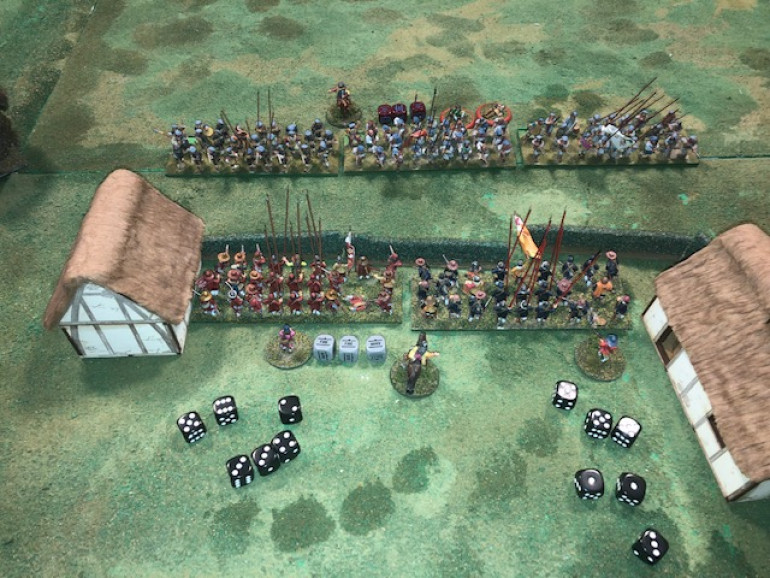 Defenders fire again at close range (5&6 = hit) - I forgot to explode the 6, but it wouldn't have made a difference
Defenders fire again at close range (5&6 = hit) - I forgot to explode the 6, but it wouldn't have made a differenceCommand Phase
It has been a while since I posted anything, mainly due to family issues, but also I have taken more time to run through my ideas of movement and fire ranges. I think I’ll be making some adjustments to these by the time I’m finished. But for now I wanted to share my thoughts on how Command will work in the rules.
One of the ideas I want to explore is whether to use “Bolt Action” style command dice approach with the variability that such a system creates but at commander level. Many rule sets use a card driven mechanism (VWQ for example), which is appealing on one level, but I wanted to try out a combination system.
As I think commanders were particularly important in the period, I have an idea that I use Bolt Action dice (or any other suitable unit of selection) but NOT to use randomly on a specific unit, but to pass that command “option” to one of the army commanders to use.
So a C-in-C might have 5/6 possible command decisions they can make in a game turn and a Wing Commander only 3 (or 4), which they can give to ALL of the units under his (or her) command. BUT that command has to be the same for ALL units.
For example, a wing commander with 4 units of cavalry can give the same command to be used by ALL four units when an appropriate army die is drawn, e.g. “Advance to point X” and this is ONE decision although all four units will carry out the move. However, if he wants 2 units to advance and the other 2 to attack a different target, he would have to remove an additional command die as these are two different command decisions.
The only point of using a “bag of dice” is to add some degree of uncertainty to the game, a “fog of war” element, if you will.
That said, I think artillery should be treated differently and using an idea from VWQ, if a particular coloured die is drawn (let’s say a RED one), ALL artillery bases on BOTH sides can then fire. If a commander wants to MOVE an artillery base, this would cost a command die.
To add another element of confusion, three additional dice (say, BLACK) are added to the bag, when the third BLACK die is drawn, the turn ends. (Sharpe Practice uses a similar dynamic). This means that as Black dice turn up, Commanders have to focus on the critical actions as the turn may end soon after.
Of course poker chips would serve just as well, and might be easier to mix as a set of poker chips come in at least five colours (IIRC) and are all the same size. So a “typical” encounter with two armies meeting would have 11 – 13 chips for each army – say Blue and White (5 per CiC and 3 / 4 for each sub commander) and 3 RED dice for the Artillery and 3 BLACK dice for turn ending panic mode.
I wanted to expand the ideas for Commanders to have some attributes as to their battlefield ability, without getting too complex. For the “simple” game the Wing commanders would get 4 dice and the Commander-in-Chief 5. But adding three qualities of Commander, this can change the potential for actions significantly.
My idea is three quality standards: Poor; Competent; Extraordinary. These qualities may be scenario specific, or in campaign mode could rise or fall depending on their success (or otherwise) in encounters, and the severity of the win/loss.
For the Command Table, a Poor Commander loses a die from the basic allocation, while an Extraordinary Commander gains a die. So in a “typical” game an army could have as few as 10 possible Commands, or as many as 16.
As to command decisions, again the Bolt Action dice can be used, albeit the actual decisions might vary. When drawn, the command dice are placed on the command table in the appropriate slot.
Run: This is the “Charge” option
Advance: A move up to standard distance
Fire: Stand and fire (any unit armed with firearms)
Rally: Attempt to restore a “cohesion” point to a unit – 2d6 needing 7+. Perhaps on a perfect 12, two points could be recovered? Officer needs to be within 10cm of unit. BUT, a failed Rally permanently reduces the maximum Cohesion value to the current level. So use wisely
Ambush: Could be used in the same way. Unit waits until enemy comes into attack range and they can then fire/enter melee without an additional die. The die would be “re-faced” to reflect the actual choice of action.
Down: Don’t move and “Reload” (reload market would then be removed). The Unit then gets the additional 2d6 on its next Fire command.
I have reworked the Unit tables as well which now reflect their respective Cohesion value. This will fall as they take casualties and as they reach particular points this affects the number of dice they roll in attacks. It also reflects their Moral factor, i.e. the number to be thrown LESS than on 2d6.
More play-testing to see how this all works.
Rule test BatRep
Scenario:
English army has entered the Borders of Scotland and have defended themselves in a village with a vital crossing point. The Scottish army has approached with the task of pushing the English back and holding the bridge.
The river is low level and crossable by all troops. However doing so NOT at the two ford sections or the bridge costs a 1” move reduction for foot units, cavalry are not restricted. Trees are impassable for all troop types.
Crossing a hedge costs Pike & Shot units 2” of movement; Highlanders lose 1” of movement. If the full move cannot be made, the unit has to halt by the hedge until the next command.
Melee can take place over a hedge without penalty.
Buildings are hard cover and block line of sight, hedges give light cover and increase “to hit” number by +1.
A roll of “6” is an exploding dice and an additional die is rolled for each perfect 6. Continue if additional 6’s occur.
Pike & Shot 5” standard move (no “charge” move)
Highlanders 6” (Charge 8”)
Cavalry 8” standard move (Charge 10”)
Pistols maximum range 5”
Muskets maximum range 12”, close range 6”
Artillery Maximum range 36”; Medium range 24”; Close range 12”
To Hit with firepower: at maximum range = 6
At close range 5+
Artillery hit on Max range (36”) 6; Medium (24”) 5+; close (12”) 4+
Unit Base dice 6d6. +2d6 if first volley (or if previous command was “down”)
Units lose a die when their Cohesion level falls into a “Red Zone”
Melee combat P&S units 6d6
Gallopers charging home against P&S 4d6; against other cavalry 6d6
Lancers first round charge 6d6, thereafter 4d6
Trotters “stand off” at short range and discharge pistols 4d6 (first volley + 2d6)
ALL to hit points in melee are 5+ (with 6 being “exploding dice”)
Turn one ended early with three white dice being drawn (these represent turn end once the 3rd is drawn) with few moves made by each side. Basically Scots advanced across the board. In reflection the “village” was somewhat of a funnel, which meant the fire fights would become very restricted. (Poor table set up by me).
Turn 2 was the complete opposite with every dice being drawn, including the 2 Artillery dice.
Scots advance continued with some fire fights taking place and casualties markers with the small discs I made last year. The casualty marker is placed on a unit for every THREE hits scored on it. This reduces their “Cohesion” level, and they have to make a moral test against this number at the end of the turn.
Failing to make the test means removal from the game as “Routed” as seen by the first casualty of the game with an English unit leaving the field of battle.
So fare, the experience with ‘exploding’ 6s works well and they did have some limited impact on the outcome of firefights.
A terrible turn for the Scottish left wing as almost the entire force was decimated by the English cavalry. Although taking some hits in return only the Gordon Horse remain fighting.
I need to think of ‘force’ breaks as this unit remained for the rest of the game whereas in reality I think it would have broken as well. It didn’t really affect the final outcome, but it may well have.
Otherwise I also want to rethink melee combat a bit more. Perhaps increase hits to 5+ rather than 6s.
Scots fight back with a good turn and cause a number of English casualties.
The “cohesion” table works well, I think with some units surviving even when their level had dropped to 5. 2d6 needing a 5 doesn’t happen too often.
An extremely short turn 5! It all depended on the final turn (turn 6) unless a 4+ on a die gives a final 7th (it didn’t).
The Scots were totally eliminated on their Left, they had pushed back the English on the Right wing with the Highlanders breaking the English units, but the centre was pretty much a stalemate as there was insufficient space between the bridge and the village for an effective fight.
Perhaps a more thoughtful battle plan would have helped, but in any case most of the rule mechanisms appears to work, although a few tweeks might be required.
A few pics of the final position follows.
A Defensive win for the English.
Draft Rules
I attach the draft rules following a few play throughs and some late changes.
As I indicated before, I drew heavily on a number of rules ideas for these, in particular “Victory without Quarter”, “Principles of War: Renaissance”, “Sharpe Practice”, and some mechanics from Bolt Action, essentially the dice drawing idea and the Command dice themselves.
Please download them and try them out. If you like them – Great; if you can think of changes, Great; if you hate them, also Great.
Enjoy

































![How To Paint Moonstone’s Nanny | Goblin King Games [7 Days Early Access]](https://images.beastsofwar.com/2024/12/3CU-Gobin-King-Games-Moonstone-Shades-Nanny-coverimage-225-127.jpg)








